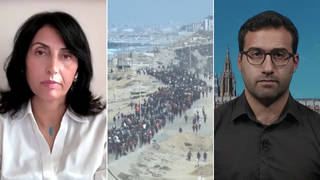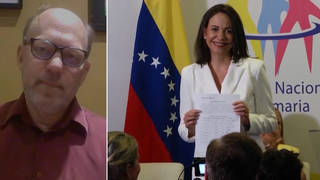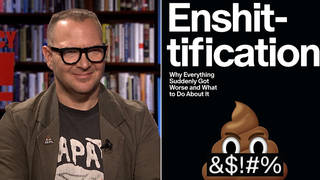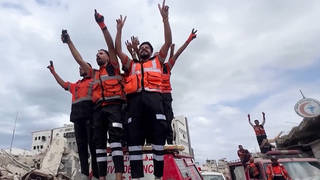
Guests
- Michael Zweigprofessor of economics and director of the Center for Study of Working Class Life at the State University of New York at Stony Brook. He is the lead author of the new study, “American Military Deaths in Afghanistan, and the Communities from which These Soldiers, Sailors, Airmen, and Marines Came.”
Nearly 1,800 U.S. military members have been killed in Afghanistan since the war began there 10 years ago — the longest war in U.S. history. A new report examines these deaths, based on information drawn from obituaries and tribute pages for all 1,446 U.S. military casualties since the war began in October 2001 until December 2010. We speak with the lead author of “American Military Deaths in Afghanistan, and the Communities from which These Soldiers, Sailors, Airmen, and Marines Came.” Michael Zweig is a professor of economics and director of the Center for Study of Working Class Life at the State University of New York at Stony Brook. “In the United States, about 62 percent of the population are in the working class,” Zweig says. “But of the casualties, it’s 78 percent who are working-class people.” [includes rush transcript]
Transcript
AMY GOODMAN: Nearly 1,800 U.S. military members have been killed in Afghanistan since the war began 10 years ago, the longest war in U.S. history. We turn now to a new report. It’s called “American Military Deaths in Afghanistan, and the Communities from which These Soldiers, Sailors, Airmen, and Marines Came.” The study is based on information drawn from obituaries and tribute pages for more than 1,400 U.S. military casualties since the war began in October 2001 ’til December 2010.
We’re joined by the study’s lead author here in New York, Michael Zweig, professor of economics and director of the Center for the Study of Working Class Life at the State University of New York, Stony Brook. He wrote and directed the film Why Are We in Afghanistan?
Michael Zweig, welcome to Democracy Now!
MICHAEL ZWEIG: Thank you.
AMY GOODMAN: You’re revealing this in the media for the first time. Lay out what you’ve found and what you’ve been most surprised by.
MICHAEL ZWEIG: Well, we looked at all these casualties and tried to understand who the people were and tried to get past the stereotypes and the sort of conventional wisdom, and then also we know what cities and towns they come from, so we looked at their communities, going through census data and other information.
So, what we found was that the casualties there are—of course, they’re young, but they are mostly with a high school education. They don’t have more than a high school education. And they are overwhelmingly white. They’re not disproportionately black and Hispanic, which a lot of people think. They’re disproportionately white.
They are not from rural areas and small towns; they’re from big cities and cities greater than 50,000 in this country. More than three-quarters come from those big cities. Now, of course, most people live in the big cities, so that there is a disproportional representation from rural areas and small towns. But really, most of the dead come from big cities and the suburban areas.
What we found was also that most of the people who are dying are not the poor. They don’t come from poor communities. They come from communities that are solidly working-class communities, that are—whose incomes in the communities are a little bit less than the median, so maybe $40,000. Forty-five thousand dollars a year is the median income in these counties. So, we look at the jobs, the occupations that the soldiers and sailors had, and also their parents, where we have that information. In the United States, about 62 percent of the population are in the working class. But of the casualties, it’s 78 percent who are working-class people. And their mothers, it’s about 75 percent, and the fathers, 73 percent, working class. So, we’re really talking about a fighting force and a dying force that’s overwhelmingly working class, much more so than the country as a whole.
AMY GOODMAN: Women?
MICHAEL ZWEIG: Well, there are not that many women who have died. Of the 1,446 that we counted from the start of the war to the end of 2010, there were 23 women. It was not enough, really, to make much of a comparison. But what was striking was that the women were almost three times as likely to have a college education as the men, and they were almost five times as likely—the women were almost five times as likely to be graduates of West Point and other—the other military academies. So that is something that is quite suggestive, that the women who are there dying are disproportionately from those academies.
AMY GOODMAN: And, of course, women are not allowed to engage directly in combat, technically—
MICHAEL ZWEIG: Yeah, technically, but—
AMY GOODMAN: —which is why there are fewer in number.
MICHAEL ZWEIG: Well, that’s right. Well, there’s a whole series of steps that go from being home and graduating from high school and dying on the battlefield. You have to be recruited. Then you have to get through basic training—that’s another filter. Then you have to be deployed to Afghanistan. And then you have to be deployed into combat zones. So, there are different filters there that we did not look into, but we just looked at the final results.
AMY GOODMAN: On this Columbus Day, Native American deaths?
MICHAEL ZWEIG: Well, the Native American deaths are a little bit less than one percent of the total. But the Native American population is a little bit less than one percent. So the population is about equally represented, maybe a little bit more represented among the casualties. But what’s really striking is that whites are way disproportionately represented in the casualties, and blacks and Hispanics underrepresented.
AMY GOODMAN: And the area of the country that they come from?
MICHAEL ZWEIG: Well, here again, often we hear they come from rural areas where there’s no real economic opportunity. It turns out to be not quite so true. As I said a minute ago, over three-quarters come from cities that have more than 50,000 people. Almost half come from cities and the suburban areas with more than a million people. The city that has the biggest casualty loss is Los Angeles—or the county, Los Angeles County, with 28. We looked at five different kinds of counties. We looked at the core, urban, major metropolitan area counties, and then their suburban ring. And then we looked at counties which have cities or around cities of less than a million but more than 50,000. And those three together count for 77 percent of all the casualties.
Now, the number of casualties is different from the casualty rates. So you can have one person die in a county in Texas with 585 people, and you have an enormous casualty rate. But that’s because there are not many people who live in that county, so one or two people who die is a big hit. In Los Angeles, the casualty rate is about two-and-a-half persons per million in the period that we’re looking at. The biggest casualty rates are actually in rural areas in the Northeast, in Maine and in upstate New York.
AMY GOODMAN: Now, it’s not as if you interviewed families—
MICHAEL ZWEIG: Right, we did not.
AMY GOODMAN: —but in terms of why people go to war, what you could gather from the tributes—
MICHAEL ZWEIG: Right.
AMY GOODMAN: —from the newspaper articles? Though it’s sort of hard when someone dies, because there’s one thing that is emphasized, whether or not the person feels this way, and that is about issues of going to war to fight for your country.
MICHAEL ZWEIG: Right, and patriotism. And we did look for reasons that were given in these obituaries and tribute pages. And there were a lot of reasons that were given, actually, and including a lot of people who talked about economic motives—the person needed a job, the person was looking for skill training, the person was looking for a way out of the community.
AMY GOODMAN: I mean, you wouldn’t write that in tributes.
MICHAEL ZWEIG: Well, you wouldn’t, but people did, you know. And actually, what we found was that about three-quarters of the tribute pages included some kind of reference to a patriotic motive—serving the country, coming from a military tradition in the family. And about 43 percent cited some kind of economic motive, like looking for a job or some other kind of economic reason for joining. So, there may be something to the so-called economic draft, but it doesn’t seem like it’s as big a deal as it is sometimes held. And that was—corresponded with what we found about the counties from which these men and women came. They come from counties where the unemployment rate and the poverty rate are no greater than, and often less than, the national average or other counties of that type. So it doesn’t seem to be that these young men and women are coming out of communities for which there is no opportunity. It seems that there is opportunity as much as anywhere else in the country, and while there may be some economic motivation, I think that we’re making a mistake if we think that all the people who are there are people of color who have no economic opportunity or poor whites who have no way out, and so they’re kind of dragooned by their economic circumstances into the military. I think that it’s important to really understand who the people actually are, so that we can build a political arrangement and we can talk to them and talk to their families on a basis of their realistic existence.
And I think it’s also important to respect and understand who’s actually doing the work. You know, we sometimes say, “Oh, we put in a new kitchen last year.” No, I didn’t put in a new kitchen; I hired somebody to put in a new kitchen. And we often sloppy-talk about how, well, we’re fighting a war in Afghanistan. Well, we’re not fighting a war; we hired some people to go do that. And it’s time that we pay a little bit more attention to the people who are actually doing the work, as opposed to the people who are running the show and sending them off to die. Although those people need to have plenty of attention focused on them, I think that it’s clear that we really do need to know more about who is doing the work. And that’s what our Center for Study of Working Class Life is all about.
AMY GOODMAN: Michael Zweig, I want to thank you very much for being with us. Michael Zweig is a professor of economics and director of the Center for Study of Working Class Life at the State University of New York at Stony Brook, lead author of this new report that we will link to called “American Military Deaths in Afghanistan, and the Communities from which These Soldiers, Sailors, Airmen, and Marines Came.”











Media Options